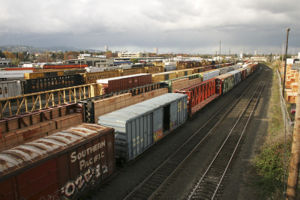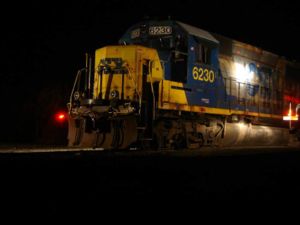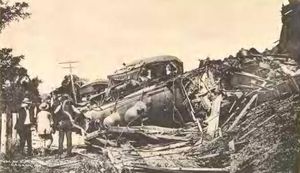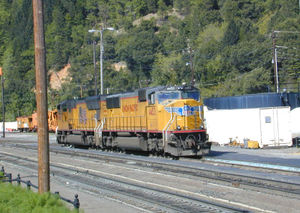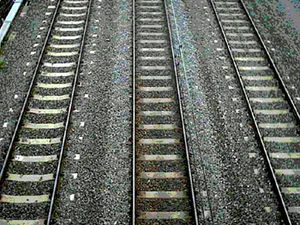Rail transport
2007 Schools Wikipedia Selection. Related subjects: Railway transport
Rail transport is the transport of passengers and goods along railways or railroads. A typical railway (or railroad) track consists of two parallel steel (or in older networks, iron) rails, generally anchored perpendicular to beams, termed sleepers ( Commonwealth) or railroad ties (U.S. and Canada), of timber, concrete, or steel to maintain a consistent distance apart, or gauge. The rails and perpendicular beams are usually then placed on a foundation made of concrete or compressed earth and gravel in a bed of ballast to prevent the track from buckling (bending out of its original configuration) as the ground settles over time beneath and under the weight of the vehicles passing above. The vehicles traveling on the rails are arranged in a train; a series of individual powered or unpowered vehicles linked together, displaying markers. These vehicles (referred to, in general, as cars, carriages or wagons) move with much less friction than do vehicles riding on rubber tires on a paved road, and the locomotive that pulls the train tends to use energy far more efficiently as a result.
General
Rail transport is an energy-efficient and capital-intensive means of mechanized land transport. Rails provide very smooth and hard surfaces on which the wheels of the train may roll with a minimum of friction. As an example, a typical wagon can hold up to 125 tons of freight on two four-wheel bogies (termed "trucks" in North America). Fully loaded, the contact between each wheel and the rail is the area of about one U.S. ten-cent piece. This can save energy compared with other forms of transportation, such as road transport which depends on rubber tires on pavement. Trains also have a small frontal area in relation to the load they are carrying, which cuts down on air resistance and thus energy usage. In all, under the right circumstances, a train needs 50-70% less energy to transport a given tonnage of freight (or given number of passengers), than does road transport. Furthermore, the rails and sleepers distribute the weight of the train evenly, allowing significantly greater loads per axle / wheel than in road transport, leading to less wear and tear on the permanent way.
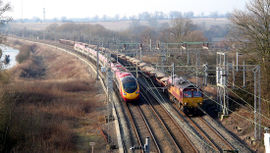
Rail transport makes highly efficient use of space: a double-track rail line can carry more passengers or freight in a given amount of time than a four-lane road.
As a result, rail transport is a major form of public transport in many countries. In Asia, for example, many millions use trains as regular transport in India, South Korea, Japan, China. It is also widespread in European countries.
Rail transport as a form of public transit in the United States is rare outside the Northeast Corridor. Few major US cities other than Cleveland, New York, Chicago, Boston, Washington, DC, and Philadelphia can lay claim to any significant use of local rail-based passenger transport; Amtrak is the only nationwide passenger rail system in the country. In Canada, the government-owned VIA Rail system provides intercity service at prices that are usually higher than bus service but lower than air travel. Toronto, Montreal and Vancouver operate rapid transit and/or light rail services that receive millions of riders a year, and Ottawa is currently in the process of expanding a light-rail pilot project.
Commercially, world rail transport has had a mixed record. Most rail systems, including urban rapid transit (metro/subway) systems, are highly subsidized and have never or rarely been profitable; however, their indirect benefits are often great. Passenger rail in nearly all countries is dependent on government subsidies. As a result levels of rail transport have in some times and places been reduced in order to save money.
Conversely, US freight railways have consolidated and become more efficient in their progress toward profitability. The four largest US railways ( Union Pacific, BNSF, CSX and Norfolk Southern) all reported profits of over $1 billion in 2005 . Canada's major rail operators, CN and CP, have been extremely profitable since the 1960s, when they abandoned most lightly-used routes and concentrated solely on freight between major points. Investments in advanced switching technology helped lower cost of operations dramatically. In more recent years both railways have expanded, buying up a number of formerly US-based companies like the Soo Line Railroad. The East Japan Railway Company has taken an innovative and creative marketing stance and have achieved profitability as a result.
It is difficult to make a complete and accurate comparison of the economics of various modes of transport as all modes benefit from substantial government, as well as private, spending. For example, public highways, aircraft manufacturers, airports and sea ports all typically receive very large capital subsidies.
Operations
A railway can be broken down into two major components. Basically these are the items which "move", the locomotives, passenger carrying vehicles (coaches), freight carrying vehicles (goods wagons / freight cars) and those which are "fixed", usually referred to as its infrastructure. This category includes the permanent way (tracks) and buildings (stations, freight facilities, viaducts and tunnels).
The operation of the railway is through a system of control, originally by mechanical means, nowadays, in most places, electronic and computerised. The volume of traffic on the line dictates the number of tracks required for its operation. Lightly used lines may be a single track, to be used by trains in both directions with "passing loops" ("passing sidings" in USA) spaced at regular intervals, regularly, although not always, at passenger stations. These consist of short stretches of double track which allow trains to pass each another. Alternatively, and particularly on freight lines, there may be longer sections of the line that are double track. These sections must be able to accommodate the longest train which normally works on that line. Effective traffic control is carried out by a "token" system. where only one token is available for each single line section. Originally this token was physically exchanged between signalman and driver, later by mechanical means using a device on the locomotive cab side whilst nowadays this system has largely been replaced by an electronic system of CTC (Centralised Traffic Control) or RETB in the uk (Radio Electric token block). The handing over of the "token" should ensure that only one train is in each single section at any one time and should prevent head - on accidents. At places where there is a limited width available for construction the double track is sometimes interlaced (see Gantlet track). Single-track lines are cheaper to build than double, but can handle only a limited amount of traffic, this being dependant on the distance between, and the length of "passing loops". They are used mainly on branch lines, except in Canada, where the four transcontinental lines are still predominantly single-track.
On busier lines, two or more main tracks are provided, for each direction of travel. On very busy lines as many as eight tracks (four in each direction) are used to handle large amounts of traffic.
With the advent of containerized freight in the 1960s, rail, road and sea transportation have become an integrated network moving bulk goods efficiently, and at relatively low cost. An example is that goods from East Asia that are bound for Europe will often be shipped across the Pacific and transferred to trains to cross North America and be transferred back to a ship for the Atlantic crossing. These goods will be unloaded at the port of arrival for transfer to their eventual destination either directly by road or, by rail to a railhead for onward movement by road.
Level
Railways are always built to stand above surrounding terrain to prevent track flooding, erosion of the bed and decay of the sleepers (ties in North America). In hilly and mountainous terrain, to avoid large slopes, the railway is at some places elevated, on an embankment or bridge/ viaduct, and at some places in a cutting ( ditch/ trench) or tunnel. The same are also used for non-level crossings. In the case of many crossings, such as in a city, a longer stretch may be elevated or underground.
Safety and railway disasters
Trains can travel at very high speed, are heavy, are unable to deviate from the track and require a great distance to stop. Although rail transport is considered one of the safest forms of travel there are many possibilities for accidents to take place. These can vary from the minor derailment (jumping the track), a head-on collision with another train coming the opposite way and collision with a car (automobile) at a level crossing (Grade crossing in US/Canada)). Level crossing collisions are relatively common in the United States where there are several thousand each year killing about 500 people - although the comparable figures in the United Kingdom are 30 and 12 (collisions and casualties, respectively). For information regarding major accidents, see List of rail accidents.
The most important safety measures are railway signalling and gates at level crossings. Train whistles warn others of the presence of a train, while trackside signals maintain the distances between trains. In the United Kingdom, vandalism or [negligence] is thought responsible for about half of rail accidents.
Railroad lines are zoned or divided into blocks guarded by combinations of block signals, operating rules, and automatic-control devices so that at most one train may be in a block at any time. Such traffic control is done in a similar way to air traffic control.
Compared to road travel, railways remain relatively safe. Annual death rates on roads are over 40,000 in the United States and about 3000 in the United Kingdom, compared with 1,000 rail-related fatalities in the United States and under 20 in the UK. (Sources: U.S. Department of Transportation and U.K. Health & Safety Executive). However, a true comparison needs to take account of the number of people using each mode.
History
The Diolkos was a 6-km long railway that transported boats across the Corinth isthmus in Greece in the 6th century BC. Trucks pushed by slaves ran in grooves in a limestone track. The Diolkos ran for over 1300 years, until 900 AD.
The first horse-drawn wagonways appeared in Greece, Malta, and parts of the Roman Empire at least 2000 years ago, using cut-stone track.
They began reappearing in Europe from around 1550, usually operating with wooden track. The first railways in Great Britain (also known as wagonways) were built in the early 17th century, mainly for transporting coal from the mine to the water side where it could be loaded on to a boat. Early examples of this can be found in Broseley in Shropshire. These had wooden rails and flanged wheels, as on a modern railway. However, the rails were liable to wear out and have to be replaced. In 1768, the Coalbrookdale Company laid cast iron plates on such wooden rails to provide a more durable bearing surface.
In the late 18th century iron rails began to appear: British civil engineer William Jessop designed edge rails (which have the flange on the rail, used with plain wheels) for use on a scheme from Loughborough, Leicestershire in 1789 and in 1790 was one of the partners who established an iron-works at Butterley, Derbyshire to produce rails (and other goods). In 1802, Jessop opened the Surrey Iron Railway in south London - arguably the world's first public railway, albeit horse-drawn.
The first steam locomotive to operate on rails was built by Richard Trevithick, and was tried out in 1804 at Merthyr Tydfil in Wales. This was not a success, partly because the engine was so heavy that the rails broke under it. In 1806 a horse-drawn railway was built between Swansea and Mumbles. In 1807 this railway started carrying fare-paying passengers - the first in the world to do so.
In 1811 John Blenkinsop designed the first successful and practical railway locomotive . He patented (No 3431), a system of moving coals by a rack railway worked by a steam locomotive, and a line was built connecting the Middleton Colliery to Leeds. The locomotive was built by Matthew Murray of Fenton, Murray and Wood. The Middleton Railway was the first railway to successfully use steam locomotives on a commercial basis. It was also the first railway in Great Britain to be built under the terms laid out in an Act of Parliament.
Blenkinsop's engine had double-acting cylinders and, unlike the Trevithick pattern, no flywheel. The cylinders drove a geared wheel which engaged under the engine with the rack. This design was quickly superseded following the discovery of railroad traction properties by George Stephenson during construction of the Stockton and Darlington Railway.
The Stockton and Darlington Railway opened in northern England in 1825 to be followed five years later by the Liverpool and Manchester Railway, considered to be the world's first "Inter City" line, which proved the viability of rail transport, with Stephenson's famous Rocket steam locomotive. Railways soon spread throughout the United Kingdom and through the world, and became the dominant means of land transport for nearly a century, until the invention of aircraft and automobiles, which prompted a gradual decline in railways.
The rail gauge (the distance between the two rails of the track) used for the Stockton and Darlington railway became known as " standard gauge" and is used by about sixty per cent of the world's railways.
The first railroad in the United States may have been a gravity railroad in Lewiston, New York in 1764. The 1810 Leiper Railroad in Pennsylvania was intended as the first permanent railroad, and the 1826 Granite Railway in Massachusetts was the first commercial railroad to evolve through continuous operations into a common carrier. The Baltimore and Ohio, opened in 1830, was the first to evolve into a major system. In 1867 the first elevated railroad was built in New York. In 1869, the symbolically important transcontinental railroad was completed in the United States with the driving of a golden spike at Promontory, Utah.
The use of overhead wires conducting electricity, invented by Granville T. Woods in 1888, amongst several other improvements, led to the development of electrified railways, the first of which in the United States was operated at Coney Island from 1892.
Richmond, VA had the first successful electrically-powered trolley system in the United States. Designed by electric power pioneer Frank J. Sprague, the trolley system opened its first line in January, 1888. Richmond's hills, long a transportation obstacle, were considered an ideal proving ground. The new technology soon replaced horse-powered streetcars.
Diesel and electric trains and locomotives replaced steam in many countries in the decades after World War II.
In the USSR the phenomenon of children's railways was developed since the 1930s (the world's first one was opened on July 24, 1935). Fully operated by children, they were extracurricular educational institutions, where teenagers learnt railway professions. A lot of them are functioning in post-Soviet states and Eastern European countries.
Many countries since the 1960s have adopted high-speed railways.
On 24 August 2005 the Qingzang railway became the highest railway line in the world, when track was laid through the Tanggula Mountain Pass at 5072 meters above sea level.
Terminology
In the United Kingdom and most other Commonwealth of Nations countries, the term railway is used in preference to railroad, while in the United States the reverse is true. In Canadian speech, railway and railroad are interchangeable, although in law railway is the usual term. Railroad was used in the United Kingdom concurrently with railway until the 1850s when railway became the established term. A number of American companies have railway in their names instead of railroad, the BNSF Railway being the pre-eminent modern example.
In the United Kingdom, the term railway often refers to the whole organisation of tracks, trains, stations, signalling, timetables and the operating companies that collectively make up a coordinated railway system, while permanent way or p/way refers to the tracks alone; however this terminology is generally not commonplace outside of the railway industry or those who take a keen interest in it.
Subways, metros, elevated lines, trolley lines, and undergrounds are all specialised railways.
Rail transport by country
Of 236 countries and dependencies, 143 have rail transport (including several with very little), of which about 90 have passenger services.
